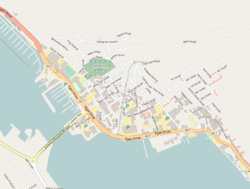The Frances House | |
 | |
| Location | 137 6th Street, Juneau, Alaska |
|---|---|
| Coordinates | 58°18′10″N134°24′41″W / 58.30278°N 134.41139°W |
| Area | 0.1 acres (0.040 ha) |
| Built | 1898 |
| Built by | Gerald Eicherly |
| Architectural style | Queen Anne, Vernacular Queen Anne |
| NRHP reference No. | 85001187 [1] |
| AHRS No. | JUN-076 |
| Significant dates | |
| Added to NRHP | June 7, 1985 |
| Designated AHRS | July 26, 1973 |
The Frances House is a historic house at 137 6th Street in Juneau, Alaska. The three-story wood-frame house was built in 1898 by Jerry Eicherly, then Juneau's postmaster. In 1911 it was purchased by John Rustgard, the Alaska Territory's attorney general, and in 1927 it was rescued from demolition by Frances Davis, a noted painter of Alaskan scenes, from whom the house derives its name. The house is a notable local example of vernacular Queen Anne styling, with a busy roofline, varied siding, and narrow Italianate windows. [2]
The house was listed on the National Register of Historic Places in 1985. [1]



